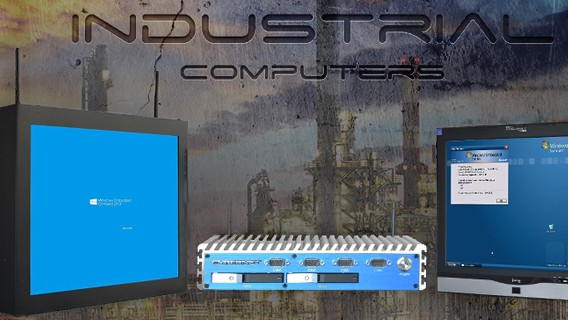With the COVID-19 pandemic, more and more people have been turning to online retail to purchase goods. Of course, higher volumes of purchases bring higher volumes of returns. Given that online retail is poised to increase its dominance in the coming decades, businesses will have to develop robust reverse logistics plans to deal with an ever-increasing volume of returns.
Unfortunately, businesses without strong reverse logistics will run into massive headaches, including increased costs, disrupted supply lines, unhappy workers, and angry customers. But, by leveraging Industry 4.0 tech like RFID-enabled Industrial Panel PCs and Rugged Industrial Tablets, businesses can maximize the efficiency of their return processes.
What is Reverse Logistics?
Article Guide
If logistics refers to the advancement of materials and products along the supply chain from the to the end-user/customer, reverse logistics refers to the opposite process: products and materials going from the end-user/customer back to the supplier.
Some industry sectors, such as print media and healthcare device manufacturers, experience a high return rate and have long factored them into their operating costs. However, many manufacturers and retailers lose money because they have yet to give reverse logistics the focus it deserves. Historically speaking, there has just not been a sufficient volume of returns to these sectors to warrant dedicating time and resources to reverse logistics. With the rise of online retail, this is changing rapidly.
Why Online Retail Increases Return Volume
The very nature of online retail inherently creates a greater demand for returns. Unlike shopping at brick and mortar stores, customers cannot examine the individual items before purchase. They cannot inspect it for defects or build quality, try it on to see if it fits, measure it, etc. The best they can hope for are high-resolution images of the product. This is true for everyone, from customers looking to buy new shoes to businesses looking to purchase new equipment.
In a brick and mortar establishment, if an item on the shelf is not to the customer’s satisfaction, they can get another one off the shelf that does. However, with online retail, customers must wait until the product they purchased is shipped to them before examining it. Should they be dissatisfied with the product for whatever reason, they must send it back, rather than just placing it back on the shelf and looking for a new one.
In the pandemic, many businesses had to shift their entire operations online, creating massive headaches for those companies that had not focused on reverse logistics.
Consumers Embrace No-Hassle Returns
You cannot discuss online retail without acknowledging the trillion-dollar elephant in the room: Amazon. Amazon’s size and dominance in the e-commerce industry mean they set the standard of service for all online retailers. If Amazon offers free shipping on orders over $25, then everyone else must also offer free shipping on orders over $25, lest they lose a customer to the retail giant. Accordingly, customers now see Amazon’s free and easy, no-questions-asked return policy as the standard for online retail.
Customers are increasingly likely to avoid online retailers with restrictive or expensive return policies because of this Amazon Effect. In fact, according to Deloitte, over three-quarters of customers said they would steer clear of online retailers that charged restocking fees or return shipping, and over half said they would avoid online retailers with short return time limits.
People want to examine their purchase at their leisure and won’t tolerate any roadblocks to returning their item should they be unsatisfied. Of course, no-hassle returns for customers can be a significant hassle for retailers without a plan to handle everything. This is where technology enters the picture.
Reverse logistics and Industry 4.0
Without an advanced reverse logistics plan in place, businesses would be crushed under the weight of e-commerce returns. Fortunately, the same Industry 4.0 technology that maximizes efficiency and minimizes costs in the forward supply chain can also maximize efficiency and minimize costs in the reverse supply chain.
However, while the Internet of Industrial Things and Big Data analysis all have important parts to play in the reverse supply chain, RFID technology, in particular, makes reverse logistics possible in the online retail era.
RFID and Blockchain
RFID, or Radio-Frequency Identification, essentially fills the role that used to be inhabited by barcodes. However, RFID offers retailers several advantages over traditional barcode technology when it comes to reverse logistics. Barcodes must be read individually, usually by a worker with a handheld scanner, and they only store limited information about a product. Reverse logistics operations that rely purely on barcodes for their asset tracking find themselves bogged down by the need to manually scan every individual item along every step of the chain.
Unlike with barcodes, a worker with a Rugged Industrial Tablet equipped with a built-in RFID scanner can scan multiple items at once at the push of a button. When things are in transit, this can help track their return using the tablet’s 5G assisted GPS capabilities. When they arrive back at the warehouse, an Industrial Panel PC can scan the RFID Tag and relay that data to an edge computing network that runs it through a big data analysis program to determine the most efficient next step in the supply chain: disposal, restocking, refurbishment, etc.
Under an Industry 4.0 paradigm, all of this data can be stored and accessed on a blockchain ledger. With each RFID scan, an item’s location and other relevant handling data are stored as an unalterable block along the blockchain. Every step of an item’s journey, from the factory to the consumer and back again, is securely logged as it is passed to different contractors along with both the forward and reverse supply chains, ensuring no returned item is lost in the shuffle.
Final Thoughts
The surge in online retail that happened due to COVID-19 is not going to recede once the pandemic ends and the world returns to normal. With more and more people buying things online rather than trying them out first a brick and mortar retail locations, more and more people will be looking to return items they would usually leave on the shelf.
Giant companies like Amazon are already catering to this desire by eliminating the usual barriers to returns like time limits and restocking and shipping fees. Businesses that do not develop a robust reverse logistics plan involving advanced Industry 4.0 technology will find themselves left behind and drowning under the volume of online returns.
If you’re interested in learning how Industrial Tablets and Panel PCs can streamline your reverse logistics processes, contact the experts at Cybernet Manufacturing today.
How Rugged Industrial Tablets Streamline Logistics
June 28, 2021
Though it often gets overlooked in our day-to-day lives, logistics – or the systems that move goods and materials from place to place – is essentially the economy’s operating system. After all, the…
0 Comments8 Minutes
Industrial Computers and the Future of Sustainability
June 7, 2021
While the upheaval caused by COVID-19 has understandably dominated global attention for the past year and a half, it has distracted from another long-simmering crisis: climate change. The pandemic will subside, but our…
0 Comments11 Minutes
Industrial Computing: Changes in the Oil and Gas Industry
September 8, 2015
The field of industrial computing has evolved to such a degree that the devices that are currently available transform the very industries that they are deployed in. There are a number of computers suitable for a…
0 Comments6 Minutes
You Can't
Learn from a Pop-up
But we can deliver knowledge to your inbox!
We dive deep in the industry looking for new trends, technology, news, and updates. We're happy to share them with you.
Knowledge, News, and Industry Updates Right in Your Inbox





